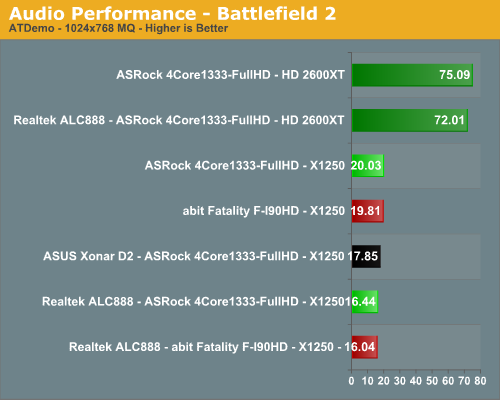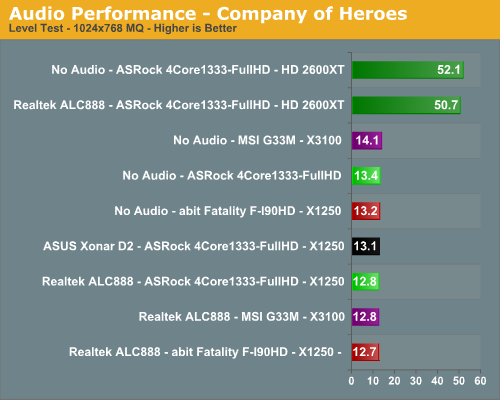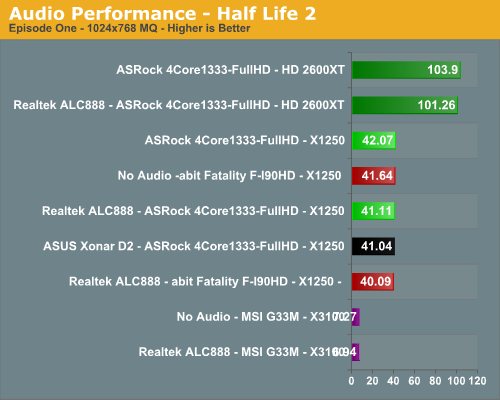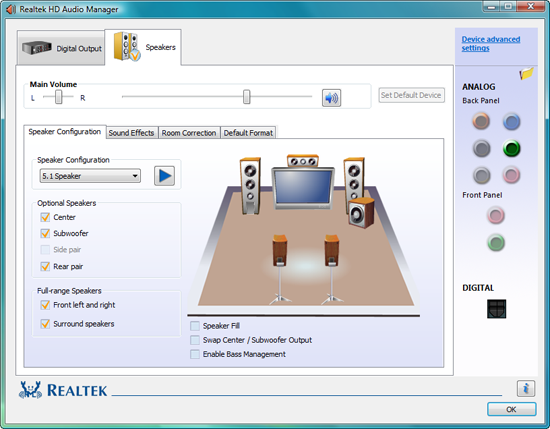µATX Part 1: ATI Radeon Xpress 1250 Performance Review
by Gary Key on August 28, 2007 7:00 AM EST- Posted in
- Motherboards
Audio Performance
Vista has brought about major changes in the audio stack and as such we will have a dedicated article on this subject along with a performance/quality comparison of the latest sound cards in a future article. The excellent Rightmark Audio Analyzer is not fully compatible with Vista yet, so objective benchmarks are not available with this tool. We expect an update to the current 6.0.5 release shortly. In the meantime, we will present game results along with subjective comments about the audio quality of the various onboard codecs.
We are no longer showing the individual CPU utilization rates as the use of a dual core processor means the driver load is balanced between each processor with our audio solutions. The 2.3 version of Rightmark properly supports dual core processors but considering the results they are almost meaningless for most users. We have found the CPU utilization rate improvements with the dual-core setup in this test do not have any bearing on actual game benchmarks as the reduction in frame rate percentages are still the same on single core systems.



The audio performance numbers remain consistent between the Realtek ALC888 and ASUS Xonar D2 solutions with either the onboard or add-in GPU. The CPU utilization rates and effects on our game benchmarks are minimal since 3D audio positioning (DirectSound 3D/EAX 2) is not available under Vista for these host-based audio solutions. This is a positive from a performance viewpoint when considering frame rate hits under XP reflect Battlefield 2 having an average loss of 22%, Half Life 2: Lost Coast at 6%, and Company of Heroes at 5%.
After comparing the ASUS Xonar D2 to the Realtek ALC888 in each of our games it was difficult to hear any substantial differences in Half Life 2: Lost Coast while there was a clear difference in Battlefield 2 and Company of Heroes. Even though 3D audio positioning is not available, the general ambient sounds and especially weapons effects definitely sound better on the Xonar D2 with explosions actually having an impact instead of sounding like a nail dropping on a tin roof. For those wondering about results with the Creative X-Fi, we hope to have those in the G33 roundup but for now the latest drivers have left us with screeching sounds in BF2 and Company of Heroes.
There was simply no comparison in our music and video playback tests where the Xonar D2 annihilated the Realtek ALC888 implementation on all three boards. This is not surprising and should be expected, but during the intense action sequence on the bridge in Mission Impossible III, the Realtek's output during the drone's flyby sequences sounded something like a beached whale when the missiles were fired and then again upon impact. We did make some adjustments with the Realtek control panel and fine tuned our speaker locations/receiver settings which did improve the audio output quality when utilizing the analog connections. These problems were somewhat mitigated when using the digital optical output on the abit board and we have to wonder what ASRock was thinking by not offering optical output on a board designed for the HTPC crowd. Either way, we suggest buying a decent audio card if you plan on using your computer as a media station.


The Vista audio control panel for the Realtek HD codec offers a wide range of options to set up your speakers, though a headphone setting and equalizer are not available. For those on a budget, the out of box experience with the Realtek solution is acceptable enough for everyday usage until one can afford a better solution.
Vista has brought about major changes in the audio stack and as such we will have a dedicated article on this subject along with a performance/quality comparison of the latest sound cards in a future article. The excellent Rightmark Audio Analyzer is not fully compatible with Vista yet, so objective benchmarks are not available with this tool. We expect an update to the current 6.0.5 release shortly. In the meantime, we will present game results along with subjective comments about the audio quality of the various onboard codecs.
We are no longer showing the individual CPU utilization rates as the use of a dual core processor means the driver load is balanced between each processor with our audio solutions. The 2.3 version of Rightmark properly supports dual core processors but considering the results they are almost meaningless for most users. We have found the CPU utilization rate improvements with the dual-core setup in this test do not have any bearing on actual game benchmarks as the reduction in frame rate percentages are still the same on single core systems.



The audio performance numbers remain consistent between the Realtek ALC888 and ASUS Xonar D2 solutions with either the onboard or add-in GPU. The CPU utilization rates and effects on our game benchmarks are minimal since 3D audio positioning (DirectSound 3D/EAX 2) is not available under Vista for these host-based audio solutions. This is a positive from a performance viewpoint when considering frame rate hits under XP reflect Battlefield 2 having an average loss of 22%, Half Life 2: Lost Coast at 6%, and Company of Heroes at 5%.
After comparing the ASUS Xonar D2 to the Realtek ALC888 in each of our games it was difficult to hear any substantial differences in Half Life 2: Lost Coast while there was a clear difference in Battlefield 2 and Company of Heroes. Even though 3D audio positioning is not available, the general ambient sounds and especially weapons effects definitely sound better on the Xonar D2 with explosions actually having an impact instead of sounding like a nail dropping on a tin roof. For those wondering about results with the Creative X-Fi, we hope to have those in the G33 roundup but for now the latest drivers have left us with screeching sounds in BF2 and Company of Heroes.
There was simply no comparison in our music and video playback tests where the Xonar D2 annihilated the Realtek ALC888 implementation on all three boards. This is not surprising and should be expected, but during the intense action sequence on the bridge in Mission Impossible III, the Realtek's output during the drone's flyby sequences sounded something like a beached whale when the missiles were fired and then again upon impact. We did make some adjustments with the Realtek control panel and fine tuned our speaker locations/receiver settings which did improve the audio output quality when utilizing the analog connections. These problems were somewhat mitigated when using the digital optical output on the abit board and we have to wonder what ASRock was thinking by not offering optical output on a board designed for the HTPC crowd. Either way, we suggest buying a decent audio card if you plan on using your computer as a media station.


The Vista audio control panel for the Realtek HD codec offers a wide range of options to set up your speakers, though a headphone setting and equalizer are not available. For those on a budget, the out of box experience with the Realtek solution is acceptable enough for everyday usage until one can afford a better solution.










22 Comments
View All Comments
Griswold - Wednesday, August 29, 2007 - link
There are a couple SM2.0 patch projects for bioshock out there. Google for it.mostlyprudent - Tuesday, August 28, 2007 - link
I am looking forward to the rest of the series.